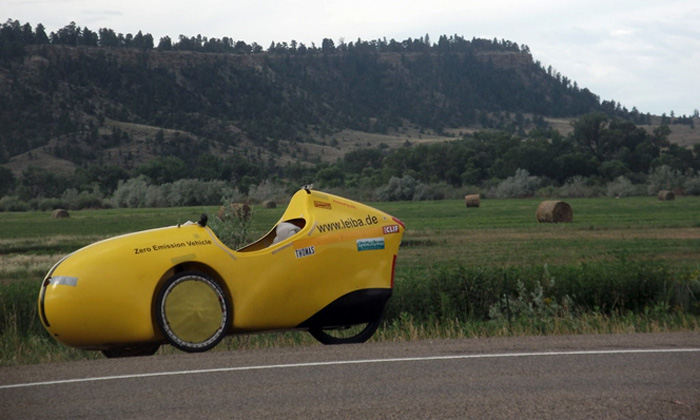Rethinking Lifestyle
What Alternative is There to the Car?

Surely living sustainably is important. We have a moral obligation to live in a way that passes a habitable planet on to our descendants. Seriously! Were we to take this moral obligation seriously, what would we do differently?
Today we examine just one aspect of our lifestyle – personal transportation, and we offer just one alternative – the velomobile.
Our default today is the car – we move 1,000 kg of steel whenever we need to move a 70 kg human. This is inherently inefficient. Most of the energy required to move the human is expended, not in moving the human, but in moving the car. We can afford this inefficiency because we have access to cheap oil, but we are using up a limited supply. This is not sustainable. Can we consider this moral living?
We are watching the development of the electric car. This is a welcome step. This is making car transportation more efficient. And certainly the car has its usefulness . It allows four or five people to travel together. But whether electric or gas powered, it still means moving 1000 kg of steel in order to move a 70 kg human.
Few people find the bicycle useful for distances longer than 5 km. In the USA, for instance, 85% of bicycle trips involve a trip of less than 5 km. Even in the Netherlands, the most bicycle-friendly country in the western world, 77% of bike trips are less than 5 km. Only 1% of Dutch bicycle trips are more than 15 km. In contrast, the average car trip amounts to 15.5 km in the USA and 16.5 km in the Netherlands, with the average trip to work being 19.5 km in the USA and 22 km in the Netherlands.
The bicycle is not a viable alternative to the car. Depending on his or her fitness, a cyclist maintains a cruising speed of 10 to 25 km/h, which means that the average commute to work would take two to four hours, there and back. A strong headwind would make it even longer, and when the cyclist is in a hurry or has to climb hills, he or she would arrive all sweaty. When it rains, the cyclist arrives soaking wet, and when it’s cold hands and feet freeze. Longer trips on a bicycle also affect the body: wrists, back, shoulders and crotch all suffer, especially when a faster bike is chosen.
An electrically-assisted bicycle solves some of these problems, but not all. The electric motor will help the cyclist reach a destination faster, or with less effort, but the cyclist remains unprotected from the weather. Longer trips still cause discomfort. Moreover, the range of most electric bicycles is limited (about 25 km). This range is just enough for the average one-way trip to work – not really enough.
Enter the velomobile – a recumbent tricycle with aerodynamic bodywork. This is a practical alternative to the bicycle for longer trips. The bodywork protects the driver (and luggage) from the weather, while the comfortable recumbent seat eases the strain on the body, making it possible to make longer trips without discomfort.
Furthermore, a velomobile (even without electric assistance) is much faster, even than an electric bicycle. This is because a velomobilist has much better aerodynamics than a bicyclist – the drag coefficient of a velomobilist is up to 30 times lower – so he or she can achieve higher speeds with the same effort.
With electric assist, the velomobile is faster yet. Velomobile enthusiasts maintain that a moderately fit person in an electric velomobile can maintain a speed of 35 to 40 km/hr.
And – when the battery of an electric velomobile drains, the velomobilist can still pedal home – at speeds above those of a bicycle. The driver of the electric car can’t do that. No more range anxiety.
If we were to be serious about the velomobile as our primary mode of transport, very much would have to change. A whole cultural shift in how we approach transportation would need to change. We would need factories for mass production and significantly altered roadways, to name but the most obvious.




